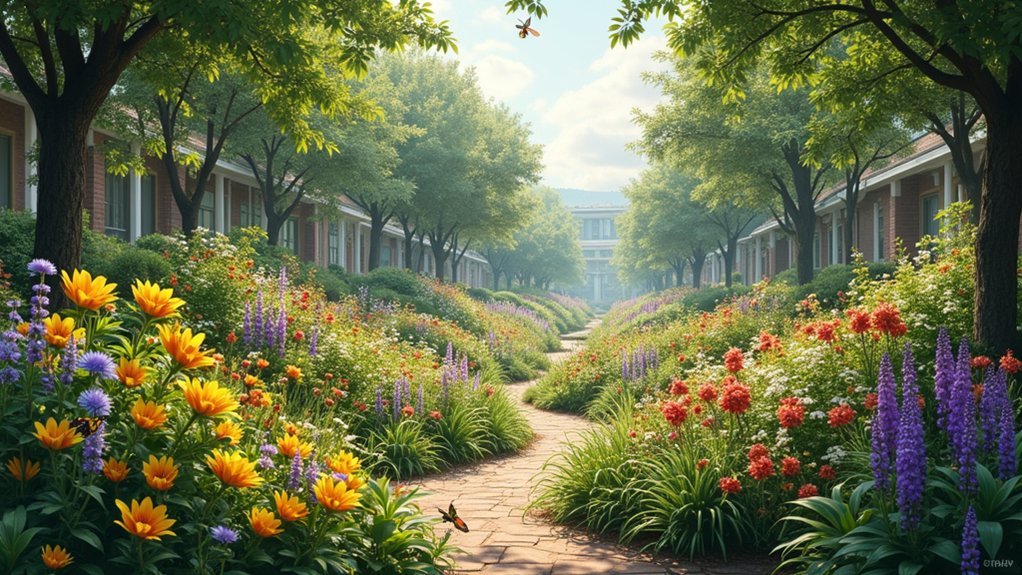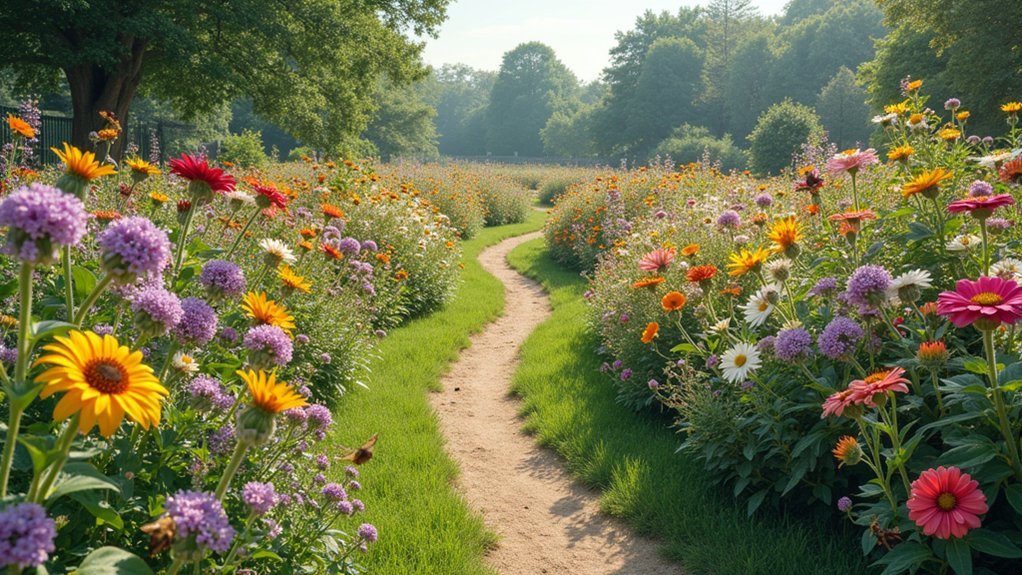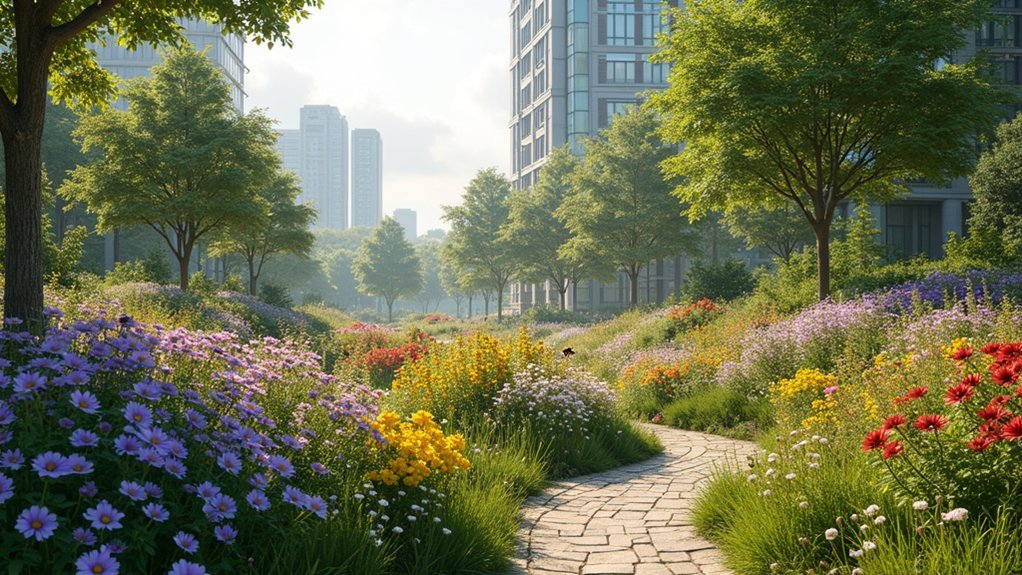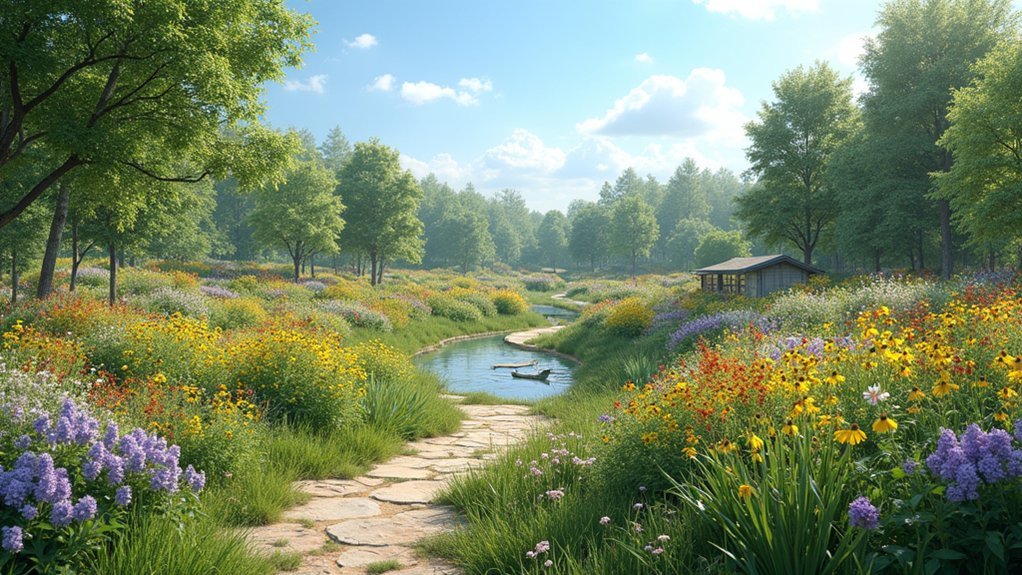Connected pollinator garden networks provide essential wildlife corridors in urban environments, supporting threatened pollinators that need continuous access to food and habitat. You'll see benefits beyond ecological restoration—these networks help cities manage stormwater, reduce urban heat islands, and boost local food security. With pollinator gardens increasing crop yields by up to 30% and creating opportunities for community engagement, they're a powerful investment in urban resilience. The growing network of interconnected habitats offers even more impressive returns.
Why Should Cities Build Connected Pollinator Garden Networks?

As cities expand and natural habitats shrink, connected pollinator garden networks offer a vital lifeline for threatened pollinators while delivering multiple benefits to urban environments.
Urban pollinator networks create essential wildlife corridors while enhancing city resilience and environmental health.
These interconnected green spaces allow pollinators to move freely throughout urban areas, supporting their reproduction and survival in increasingly fragmented landscapes.
With over 40% of insect pollinators at risk and one-third of bee species depending on specific native plants, these networks provide essential habitat continuity.
They're not just good for wildlife—they help cities manage stormwater, reduce urban heat, and enhance overall environmental health.
The Critical Role of Habitat Connectivity in Urban Pollinator Survival
Habitat corridors function as lifelines for urban pollinators, connecting isolated green spaces and allowing species to access critical resources they'd otherwise miss.
Your backyard can serve as a crucial bridge in this network, linking neighboring gardens to create pathways that butterflies, bees, and other pollinators use to navigate the urban landscape.
When you plant pollinator-friendly species that connect with nearby gardens, you're not just creating a pretty space—you're constructing an indispensable highway that helps threatened species survive in fragmented urban environments.
Corridors Save Species
When cities fragment natural landscapes, pollinators face a life-threatening challenge: traversing between isolated patches of habitat.
These disconnected urban environments force pollinators to navigate through inhospitable areas, reducing their access to food and nesting sites.
You'll see remarkable benefits when you connect pollinator habitat through strategic corridors.
These pathways enable native pollinators to move efficiently between larger habitat areas, with small gardens serving as essential stepping stones.
For the 70% of native bees that nest in soil and the 30% that use cavities, connected habitats provide diverse nesting options and consistent food sources.
Backyard Bridges Matter
Your backyard isn't just a personal sanctuary—it's an essential link in an urban ecological chain.
When you create pollinator gardens that connect to your neighbors', you're building vital bridges that help pollinators navigate through fragmented urban landscapes.
These connections matter greatly for native bees, with about 70% nesting in the ground and depending on nearby flowering plants for survival.
They need consistent access to food and nesting sites that isolated gardens can't provide alone.
Creating Foraging Highways: How Connected Gardens Support Pollinator Movement

The strategic placement of pollinator-friendly gardens creates essential lifelines for bees, butterflies, and other pollinators as they navigate increasingly fragmented landscapes.
Thoughtfully planted pollinator havens bridge fragmented ecosystems, offering vital support to struggling bee and butterfly populations.
When you connect your garden to others in your neighborhood, you're building vital habitat corridors that function as foraging highways.
These interconnected pollinator gardens serve as stepping stones between larger natural areas, allowing pollinators to move safely through urban environments.
Research confirms that cities with these garden networks show measurable increases in both pollinator abundance and diversity.
The Million Pollinator Garden Challenge demonstrates this impact, with over one million registered gardens now supporting pollinator populations across America.
Seasonal Bloom Planning for Year-Round Pollinator Support
Designing a garden with sequential blooms throughout the seasons creates a continuous buffet for pollinators that depend on reliable nectar and pollen sources. You'll find most yards lack sufficient spring and fall flowering options, creating hunger gaps for bees and butterflies. Remember, one-third of bee species require specific native plants for their survival.
| Season | Common Gap Periods | Recommended Native Plants |
|---|---|---|
| Spring | Early March-April | Serviceberry, Wild Geranium |
| Summer | Late July-August | Coneflower, Bee Balm |
| Fall | October-November | Aster, Goldenrod |
Effective seasonal bloom planning requires tracking flowering times across your garden. By intentionally selecting native plants that flower during underrepresented periods, you'll create year-round pollinator support that strengthens the entire garden network in your community.
Beyond Beauty: The Ecological Functions of Connected Garden Networks

While aesthetically pleasing flower beds may catch the eye, connected pollinator garden networks serve far more vital ecological functions beyond mere visual appeal.
You're actually creating environmental infrastructure when you establish these interconnected spaces. Connected pollinator gardens greatly improve stormwater management and reduce urban heat island effects, making your city more resilient to climate change.
These networks transform unused urban spaces into vibrant ecosystems that boost urban biodiversity. They provide essential movement corridors for pollinators seeking food and nesting sites across fragmented landscapes.
Native plants are particularly important—one-third of bee species depend on specific native flora for pollen. By linking gardens that feature season-spanning blooms, you're ensuring consistent nutrition for pollinators year-round, addressing the common gap in spring and fall resources within urban settings.
Native Plant Selection for Maximum Pollinator Benefit
When selecting native plants for your pollinator garden, prioritize regional species diversity as these plants co-evolved with local pollinators and support one-third of specialized bee species.
You'll want to contemplate bloom timing by incorporating natives that flower in different seasons, ensuring continuous food sources and eliminating gaps in nectar availability.
Start with host plants that serve as nurseries for pollinator larvae, as these foundation species create the ecological backbone that attracts and sustains diverse pollinator communities in your garden network.
Regional Species Diversity
As gardeners establish pollinator-friendly spaces, native plant selection emerges as the foundation for successful ecological support. When you choose native plants for public spaces, you're creating habitat that directly supports local pollinators through co-evolved relationships. Nearly one-third of bee species depend on specific native plants for survival.
| Region | Key Native Plants | Primary Pollinators |
|---|---|---|
| Northeast | Goldenrod, Aster | Bumble bees, Monarchs |
| Southeast | Milkweed, Coneflower | Swallowtails, Mining bees |
| Midwest | Prairie Clover, Compass Plant | Honey bees, Skippers |
| Southwest | Penstemons, Desert Marigold | Carpenter bees, Hummingbirds |
| Northwest | Salal, Oregon Grape | Mason bees, Fritillaries |
You'll find that incorporating diverse native flowering species guarantees continuous blooming throughout seasons, filling essential gaps in nectar availability while requiring less maintenance and water than non-natives.
Bloom Timing Matters
Native plant selection goes beyond simply choosing regional species—the timing of when these plants bloom creates the backbone of effective pollinator support.
You'll need to select plants that flower sequentially throughout the growing season to provide continuous nectar and pollen resources.
Remember, about one-third of bee species rely on specific native plants for pollen, making thoughtful selection essential for supporting diverse pollinator populations.
Most urban yards suffer from "bloom gaps," especially during early spring and late fall when many pollinators remain active but find few food sources.
Host Plants First
While choosing plants that bloom throughout the season creates essential feeding opportunities, selecting the right host plants represents the foundation of any successful pollinator garden.
These native plants aren't just food sources—they're significant habitats that directly support pollinators throughout their life cycles.
When you prioritize native plants, you're addressing the specialized needs of local pollinators.
Consider that one-third of bee species rely on specific native plants for pollen, while butterfly and moth caterpillars can only develop on certain host plants.
By incorporating these important species, you'll nurture more diverse pollinator populations.
Native plants offer practical benefits too—they typically require less water and no pesticides.
Use the National Wildlife Federation's Native Plant Finder to select appropriate local species that will maximize your garden's ecological value within your city's connected pollinator network.
Designing Multi-Functional Nesting and Overwintering Habitats
Creating effective pollinator habitats requires more than just planting attractive flowers—you'll need to provide the vital nesting and overwintering sites that complete a pollinator's life cycle.
Remember that about 70% of native bees nest in the ground while 30% prefer cavities, so your pollinator gardens should include both options.
Integrate stem stubble, bare soil patches, leaf litter, and brush piles throughout your urban habitat to support diverse bee species.
These microhabitats serve double duty, offering nesting opportunities during active seasons and essential refuge during winter months.
When planning green infrastructure in urban settings, connect these multi-functional spaces to create habitat corridors that facilitate pollinator movement.
The most successful gardens pair flowering plants with appropriate nesting materials, ensuring pollinators can both feed and reproduce in your space.
Community Engagement and Workforce Development Opportunities

As pollinator gardens transform urban landscapes, they simultaneously cultivate robust community ties and valuable job skills.
You'll find evidence of this in the impressive installation of over 350 plants across five pollinator gardens by community volunteers, demonstrating how these green spaces foster local stewardship.
Workforce development initiatives, like partnerships with Urban Greenscapes, provide participants with lifelong job skills while they maintain pollinator habitats.
Participants gain lasting career skills through Urban Greenscapes collaborations while stewarding essential pollinator ecosystems.
These collaborative efforts, often supported by grants from organizations such as The Home Depot Foundation, emphasize the importance of community engagement in conservation.
Economic Benefits: Urban Agriculture and Food Security Enhancement
Connected pollinator gardens extend beyond social benefits to deliver significant economic advantages through enhanced food production systems.
When you establish these networks in urban areas, you're creating a foundation for local food security and economic growth. Research shows these gardens can boost crop yields by up to 30%, as they support the pollinators needed for 80% of crop plants.
The economic opportunities are substantial – pollinator-friendly urban agriculture strengthens local farmers' markets and generates millions in revenue.
These plant networks reduce dependence on imported produce while creating resilient local food systems. Additionally, they provide practical benefits by mitigating heat island effects and improving stormwater management, creating healthier environments for growing food where people live.
This integration ultimately transforms cities into productive, sustainable foodscapes.
Building Resilience: How Pollinator Networks Strengthen Urban Ecosystems

While cities face mounting environmental challenges, strategically designed pollinator garden networks serve as powerful resilience-building tools within urban landscapes.
These connected habitats create vital movement corridors for pollinators and wildlife, enabling them to access food and nesting sites across fragmented urban areas.
Creating wildlife superhighways in our concrete jungle—these green pathways reconnect fractured ecosystems where city life has divided nature.
Native plants in these networks deliver essential ecosystem services, including improved stormwater management and heat island mitigation.
You'll find these gardens require less water and eliminate the need for harmful pesticides, naturally strengthening your local ecological systems.
Pesticide Reduction Strategies Across Connected Garden Systems
Coordinated pest management across your connected garden network begins with implementing shared IPM practices that prioritize biological controls over chemical interventions.
You'll strengthen your pollinator habitats by intentionally cultivating plants that attract beneficial predators like ladybugs, lacewings, and parasitic wasps that naturally control pest populations.
Coordinated Pest Management Plans
Successful pollinator garden networks depend on thoughtful pest management strategies that minimize chemical interventions across all connected spaces.
You'll find that implementing integrated pest management across interconnected gardens creates a systematic approach that protects beneficial insects while addressing pest concerns naturally.
When you coordinate pest control methods between garden sites, you're able to support pollinator populations by reducing overall pesticide exposure throughout their foraging range. This means establishing shared protocols for identifying pest thresholds, utilizing biological controls, and preserving natural areas that harbor predatory insects.
Community-wide agreements to use untreated plants and native species further strengthens your network's resilience.
Native Predator Attraction
Instead of relying on chemical solutions, you'll find that attracting native predators serves as the cornerstone of pesticide reduction across connected garden networks.
When you establish interconnected gardens with diverse native plants, you're creating habitat for beneficial insects that naturally control pest populations.
These predatory allies—from ladybugs to parasitic wasps—maintain ecological balance without harmful chemicals that threaten the 40% of pollinators already at risk from pesticide exposure.
Research confirms that floral-rich gardens greatly boost pollinator populations while simultaneously supporting these natural pest controllers.
Biodiverse Spray-Free Zones
Creating biodiverse spray-free zones forms the backbone of effective pesticide reduction across interconnected garden networks.
When you establish these pesticide-free havens, you're providing safe corridors where bee species and other pollinators can thrive without chemical exposure.
Research shows these protected environments support wildlife diversity up to 50% greater than conventionally managed spaces.
Frequently Asked Questions
Why Is It Important to Create Pollinator Gardens?
You'll support biodiversity by creating pollinator gardens. They're essential for bees and butterflies, providing food and habitat while ensuring plant reproduction. Your garden helps maintain ecosystem health and food security.
Why Is It Important to Create Spaces for Pollinators?
You're creating essential havens for declining pollinators when you build spaces for them. They'll pollinate your food crops, increase biodiversity in your area, and help maintain the ecological balance you depend on.
Why Are Local Pollinators Important?
Local pollinators are essential because they fertilize your food crops, maintain biodiversity in your neighborhood, and support ecosystem health. They're irreplaceable neighbors who've evolved alongside local plants for mutual survival.
Why Are Pollinator Pathways Important?
Pollinator pathways are important because they connect fragmented habitats, allowing bees and butterflies to travel safely. You'll help these essential creatures find food, shelter, and breeding sites while supporting biodiversity in your community.
In Summary
You've got the power to transform your city into a buzzing haven for pollinators. By connecting garden spaces, you're creating crucial lifelines for these essential creatures while strengthening food security, building climate resilience, and bringing communities together. Don't wait—plant that native wildflower patch and join your neighbors in weaving a living network that'll sustain both pollinators and people for generations to come.





Leave a Reply